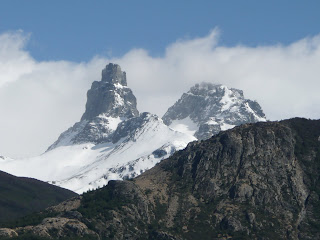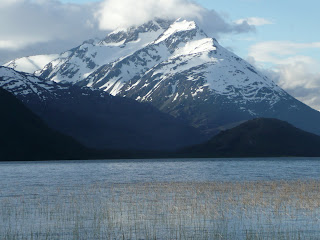
Give me some latitude!
63 Degrees of Separation
Villa O´Higgins is at 48°south and since leaving Santa Marta on the Caribbean coast I´ve crossed 63 latitudinal belts on the ride down the Andean chain.
Give me some distance!
Total kms so far - 13052kms (Pete) Jude - 8100kms (mas o menos)
Cerro Castillo. In 1993 we spent 4 days hiking among these peaks- memories of suspended glacial lakes, condors and metallic blue peaks. Now riding and marvelling from a distance.
The ride south just got better and better. You can see the evidence of the recent unseasonal wild weather which blanketed Patagonia in heavy snow. At this point, we were still rugged up as the westerly wind still blew hard into our faces. 



Steep climb ahead! 
Our campsite was down on the shores of Lago General Carrerra, a beautiful spot. This lake is the second largest in South America after Lake Titicaca.


The road winding its way around the lakes. Lots of steep ups and downs.

San Lorenzo Massif south of Cochrane.
View of the cordillera at sunset from our campsite

Jude riding on the bumpy stoney road. The Carreterra Austral from Futalefu to Villa O´Higgins is mostly unpaved and quite rough in parts- with lots of loose gravel and steep sections. We pedalled 1057kms of which only 253kms were sealed (north and south of Coyhaique).

Heading further south from Cochrane to Tortel, at the foot of El Campo del Hielo Norte (Northern Patagonian Icefield).


Tortel village nestling in a fjord. This village has only had road access since 2003 and the houses are linked by wooden walkways. In 1993 we hitchhiked as far as Cochrane but the road hadn´t reached Tortel.

The road to Tortel was only 20kms off the main route but it was an awful bumpy ride. In that short distance I broke a brake cable, cracked the bracket mount for my front rack (luckily found a replacement in Tortel), broke a spoke in my rear wheel, and a hook from my rear pannier came adrift. Not sure if it was all coincidence but it seemed strange after 3000kms since my last repair. After 8000kms Jude still has only had 2 punctures. I´ve had 7 punctures in 13000kms, mostly in Argentina and on sealed roads. 4000kms in Peru without a flat!
Our campsite beside Rio Baker. The river begins its journey to the Pacific from Lago Bertrand as a deep aquamarine colour and as it flows south gradually changes its hues as tributaries dilute and lighten it just as an artist might taint a palette.


Rio Baker - one of the two rivers which is now in danger of being inundated by hydro-electric dam projects. The other is Rio Pascua further south and in a much more wild and remote region (on the edge of a National park). The former receives the snowmelt from the Northern Patagonian Icefield whereas the latter collects the melt from the Southern Icefield.


The road snaking above Rio Baker

Protests similar to the No Dams movement in Tasmania of the 70s and 80s are now emerging in Chile with lots of local opposition to the environmental destruction of Patagonia´s wild places. Google search ´Patagonia Sin Represas´ (Patagonia without Dams) for more info on the fight to save these wild rivers.


FLORA
On the road I had many opportunities to observe and photograph some unique and magical Patagonian flora and fauna.
Green Gondwanan mosaic on alpine moorland at 400m. All three plants share a genus in Tasmania - Lycopodium or clubmoss, Nothofagus and Podocarpus or alpine creeping pine.

Guaitecas cypress or lahuan (Mapuche language) showing pine needles and scaly bark.

The alerce tree Fitzroya cupressioides or Patagonian cypress which grows in the Valdivian forests further north is a much larger and longer-living pine. It is the second oldest tree species in the world and one of the largest. Another Gondwanan relic whose ancient relative once grew in Tasmanian humid temperate forests (give or take 130 million years ago). Now only 15% of the original alerce forests are left. They have ben exploited for their durability and used extensively for the shingled houses seen from Chiloe Is. to the Aisen region. I will add some photos here of the shingled buildings in Aysen.
Chloraea alpina - a flamboyant orchid on the moorland above Rio Baker.

Dog orchid (`palomita´) Codonorchis lessonii - the floor of a lenga forest, beside our campsite, was carpeted with these orchids.


Anemone

Ourisia poeppigii , growing in clumps on the edge of a waterfall. Ourisia is a trans-Pacific genus and one species is found in Tas and 14 in New Zealand.
 LOS AVES
LOS AVES Canquen colorado, or ashy-headed goose.

Crested ducks on Lago Verde

Campephilus magellanicus Carpintero gigante (Spanish) Male and female magellanic woodpeckers

Male carpintero with its red tufted crown brilliant in the sunlight.

Vultur gryphus Condor de Los Andes.

This condor, possibly a juvenile, was in a group of four and it circled and glided above us for 30 minutes, at one point only 5 metres from our heads.

Cisne de Cuello Negro or Black-necked swans on Lago Cisnes
 Other birds seen along the way but didn´t get good enough photos - hummingbirds (picaflor gigante) feeding on fuchsia nectar, kingfishers (martin pescador) flying low and swift over raging rivers and lots of raucous bandurrias, or buff-necked ibis in the marshlands.
Other birds seen along the way but didn´t get good enough photos - hummingbirds (picaflor gigante) feeding on fuchsia nectar, kingfishers (martin pescador) flying low and swift over raging rivers and lots of raucous bandurrias, or buff-necked ibis in the marshlands. LA FAUNA
Just after we were entranced by the flight of the condor, a lone male huemul emerged from the scrub. This species of deer is as rare as the pudu (the miniature deer I saw in Quelat)- with a population of only 4-5000. It was a real pleasure to witness this animal so close. It seemed very tame and we watched it nonchalantly eating leaves of the notro (or firebush, the red Proteacea in the background). As a lone male he must have been an outcast and he appeared to be injured, old or sick. It has lost most of its winter coat and looks a bit ragged and under-dressed.


Judy on the road from Rio Bravo to Villa O´Higgins

The waterfalls on the final section of the road were spectacular, heavy from snowmelt and crashing, splashing down the precipitous slopes.

Lake Cisnes from our last campsite

Late evening on Lago Cisnes - clouds, peaks and ripples

Arrival in Villa O´Higgins at the end of La Carretera Austral.






1 comment:
AMAZING photos Pete. Thanks...Would love to see your video but the link in this email doesn't work, so will try from the blog instead...nah! no link there..please re send :o) NB: Can't you load the video in here??
Post a Comment